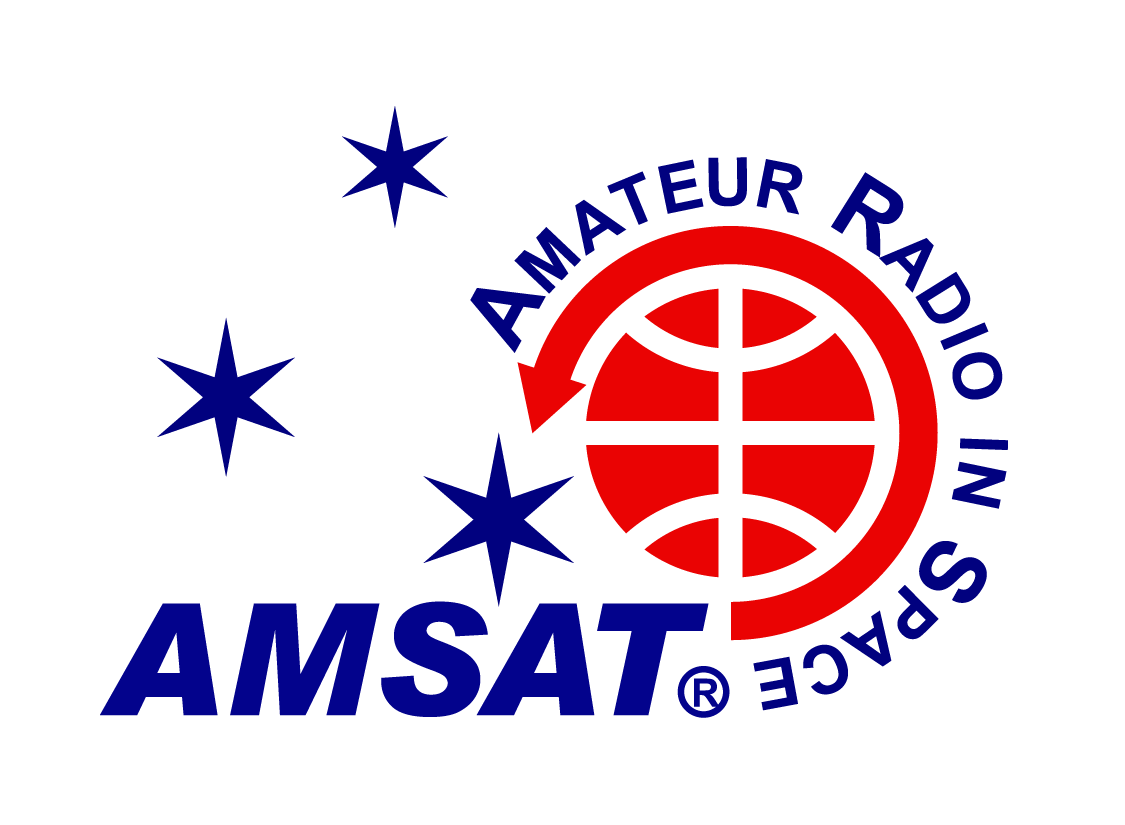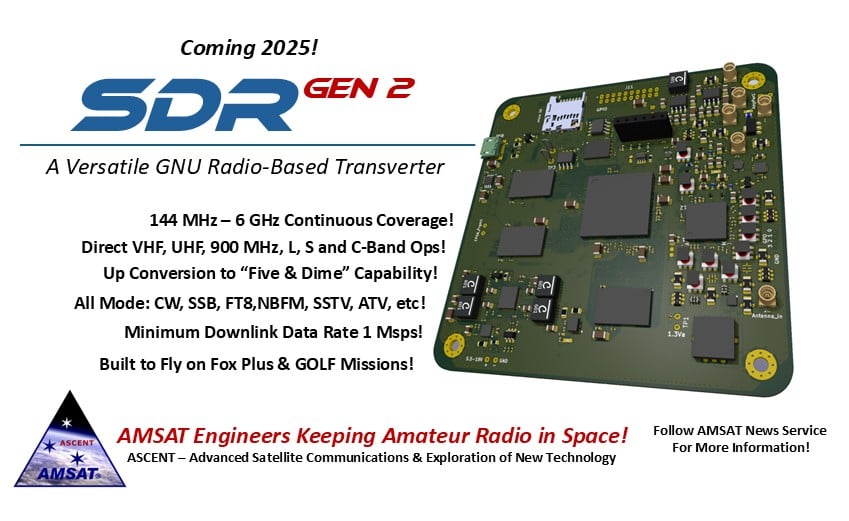In this edition:
* Welcome SO-125! AMSAT-EA’s HADES-ICM Joins the OSCAR Fleet
* Your Voice, Your Board: Nominate Now for 2025 AMSAT Election
* Another Batch of CubeSatSim Kits Available Soon in AMSAT Store
* SpaceX Starship Ninth Flight Yields Data, Misses Reentry Goals
* Japanese Private Lander Resilience Nears Lunar Touchdown
* GridMasterMap Satellite Top 100 Rovers June 2025 Rankings
* Changes to AMSAT-NA TLE Distribution for May 30, 2025
* ARISS News
* AMSAT Ambassador Activities
* Satellite Shorts From All Over
The AMSAT News Service bulletins are a free, weekly news and information service of AMSAT, the Radio Amateur Satellite Corporation. ANS publishes news related to Amateur Radio in Space including reports on the activities of a worldwide group of Amateur Radio operators who share an active interest in designing, building, launching and communicating through analog and digital Amateur Radio satellites.
The news feed on https://www.amsat.org publishes news of Amateur Radio in Space as soon as our volunteers can post it.
Please send any amateur satellite news or reports to: ans-editor [at] amsat.org
You can sign up for free e-mail delivery of the AMSAT News Service Bulletins via the ANS List; to join this list see: https://mailman.amsat.org/postorius/lists/ans.amsat.org/
ANS-152 AMSAT News Service Weekly Bulletins
To: All RADIO AMATEURS
From: Radio Amateur Satellite Corporation
712 H Street NE, Suite 1653
Washington, DC 20002
DATE 2025 Jun 01
Welcome SO-125! AMSAT-EA’s HADES-ICM Joins the OSCAR Fleet
AMSAT-EA’s HADES-ICM satellite, a 1.5U PocketQube carrying an SDR-based FM and digital repeater payload for amateur radio use, was launched on March 14, 2025, aboard a Falcon 9 rocket during SpaceX’s Transporter-13 mission from Vandenberg Space Force Base in California.
Following deployment from the ION-SCV-017 Orbital Transfer Vehicle (OTV) on March 31, the satellite has been undergoing commissioning. The FM repeater is expected to be activated in June—initially on weekends, with plans to eventually transition to full-time (24/7) operation, as is currently the case with AMSAT-EA’s earlier HADES-R mission.
HADES-ICM also hosts an experimental payload from the University of Manchester’s Smart IR/Graphene Engineering Innovation Centre (GEIC), designed to test a very low-power active radiator under space conditions. Data from this experiment will be publicly transmitted via telemetry packets.
The satellite carries an FM and digital repeater payload, built on an improved SDR-based platform capable of transmitting up to 0.25W when battery conditions allow. This makes it accessible to stations using handheld antennas like the Arrow antenna. The coordinated uplink frequency is 145.875 MHz, and the downlink is 436.666 MHz. The repeater operates with an open squelch and does not require a subtone. The satellite has been cataloged with NORAD ID 63492.
At the request of AMSAT-EA, AMSAT hereby designates HADES-ICM as SO-125 (Spain-OSCAR 125). We congratulate AMSAT-EA, thank them for their continued contributions to the amateur satellite community, and wish them success with this and future missions!
[ANS thanks Drew Glasbrenner, KO4MA, AMSAT VP Operations / OSCAR Number Administrator for the above information]
Your Voice, Your Board: Nominate Now for 2025 AMSAT Election
AMSAT has officially opened the nomination period for its 2025 Board of Directors election, which will take place during the third quarter of the year.
Four director positions are set to expire in 2025. The current board members whose seats are up for election are:
- Barry Baines, WD4ASW
- Jerry Buxton, N0JY
- Drew Glasbrenner, KO4MA
- Zach Metzinger, N0ZGO
In addition to these four full Director roles, up to two Alternate Directors may also be elected to serve one-year terms.
To nominate a candidate, a written submission is required. Nominations must include the nominee’s name, call sign, and contact information, along with the same details for either five AMSAT members in good standing or one Member Society endorsing the candidate.
Nominations should be directed to the AMSAT Secretary:
Douglas Tabor, N6UA
1133 Verlan Way
Cheyenne, WY 82009
Per AMSAT’s bylaws, all nominations must follow the format specified by the Secretary. Doug Tabor has indicated that nominations will be accepted in both hard copy (via postal mail) and digital formats (including email or scanned documents). However, fax submissions are not permitted.
Email nominations should be sent to: dtabor [at] amsat [dot] org
All nomination petitions must be received by the Secretary no later than June 15th. After the submission deadline, the Secretary will confirm the eligibility of each candidate and the supporting members or societies, with final notification to candidates provided by the end of June.
[ANS thanks Doug Tabor, N6UA, AMSAT Secretary, for the above information]
Another Batch of CubeSatSim Kits Available Soon in AMSAT Store
A new batch of CubeSatSim Kits will be available for purchase in the AMSAT Store (https://www.amsat.org/product/cubesatsim-kit) on Thursday, June 5th, at 7 pm US Eastern time. Priced at $550 with shipping included for U.S. addresses, the CubeSatSim Kit offers a hands-on learning experience with no soldering and some assembly, making it ideal for both educational use and public demonstrations.
The CubeSatSim Kit includes:
- Fully assembled and tested PCBs (Main, Solar, and Battery Boards)
- Raspberry Pi Zero 2 with a Pi Camera and fully programmed micro-SD card, along with a fully programmed Raspberry Pi Pico WH
- AMSAT logo Remove Before Flight tag switch
- 3D printed frame, nylon screws, and nuts, with a mini screwdriver included for assembly
- Metal standoffs, stacking headers, and JST jumpers for stacking the PCBs and Pi Zero 2
- 10 solar panels with pre-soldered JST connectors and mounting tape
- BME280 sensor (pressure, temperature, altitude, humidity) and MPU6050 IMU/gyro pre-soldered
- Two 6″ SMA coax cables and two SMA antennas
The kit also comes with an instruction sheet, parts inventory, and links to online instructions. Assembly time is estimated to be under two hours, with scissors and the provided mini screwdriver.
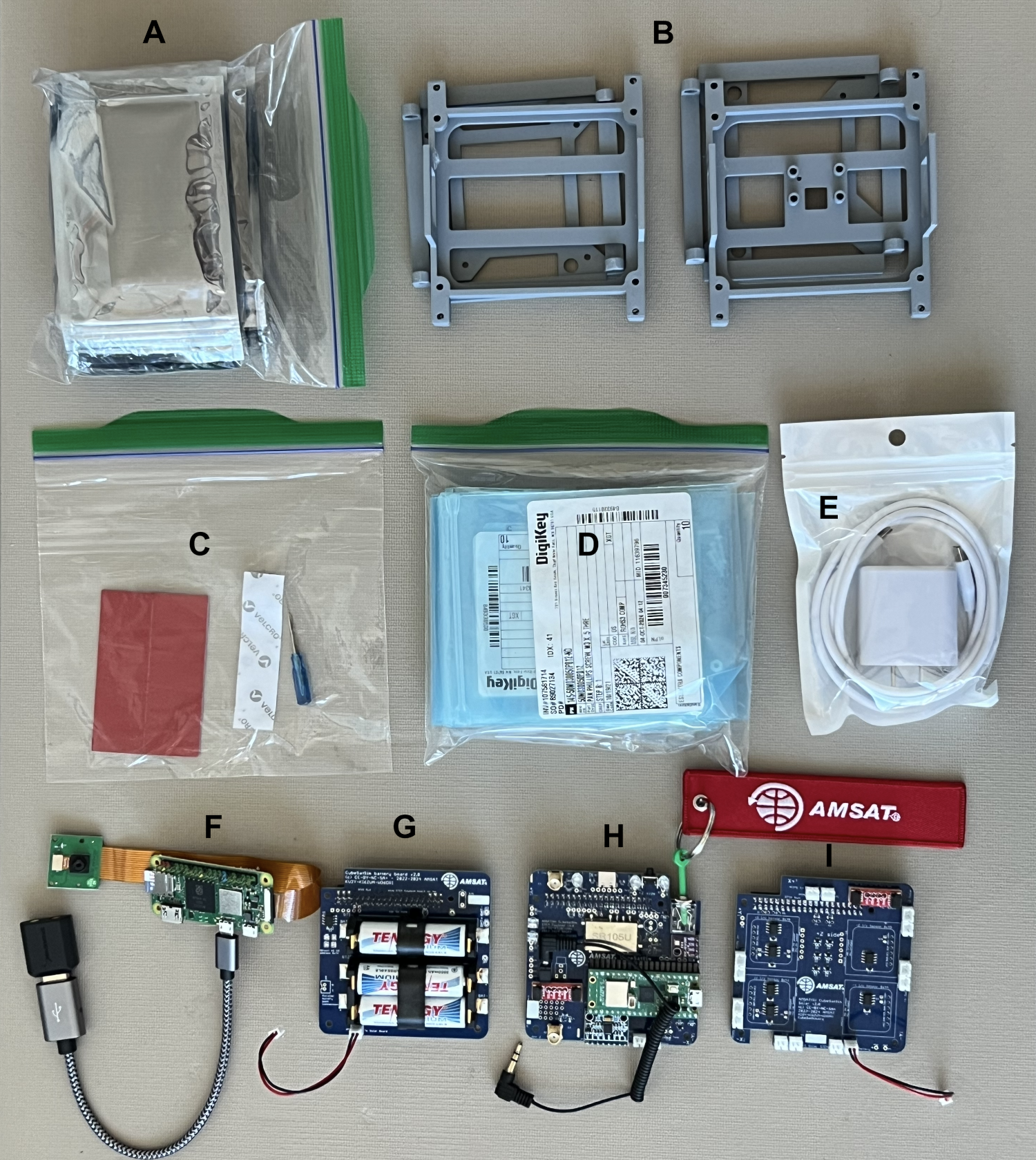
For those interested in creating their own CubeSatSim, v2.0 blank PCB sets are available at the AMSAT Store for $35. These require additional components, which can be purchased for approximately $400 using the provided Bill of Materials.
Additional resources include:
- Kit Instructions https://cubesatsim.org/kit
- Kit Videos https://cubesatsim.org/kit-videos
- Discussion Forum https://github.com/alanbjohnston/CubeSatSim/discussions
- Quick Start Guide https://cubesatsim.org/qsg
For more information or to borrow a loaner CubeSat Simulator, contact Alan Johnston, AMSAT VP Educational Relations, at ku2y [at] arrl.net.
How to Order
Kits will be sold exclusively on the AMSAT Store website.
Only U.S. shipping addresses are eligible; orders with non-U.S. addresses will be refunded and closed.
About CubeSatSim
CubeSatSim is a low-cost satellite emulator powered by solar panels and batteries. It transmits UHF radio telemetry and can be expanded with additional sensors and modules, making it ideal for educational and public demonstrations.
[ANS thanks Alan Johnston, KU2Y, AMSAT Vice President Educational Relations for the above information]
SpaceX Starship Ninth Flight Yields Data, Misses Reentry Goals
SpaceX achieved partial success Tuesday with the ninth test flight of its massive Starship rocket, overcoming prior engine shutdown problems but discovering new issues during the vehicle’s return from space. Launched from the company’s Starbase facility in South Texas, the rocket reached space and achieved full engine cutoff for the first time using its current Block 2 design. However, the upper stage lost control during coast and reentry phases, tumbling and eventually disintegrating over the Indian Ocean.
The early stages of the mission went according to plan. All 33 Raptor engines on the Super Heavy booster ignited successfully, pushing the rocket skyward with twice the thrust of the Saturn V. After separation, the Starship upper stage ignited its own engines and reached a near-orbital trajectory. Elon Musk confirmed on X that the main engines completed their full burn and that the heat shield tiles remained intact during ascent—both major improvements over previous tests.
But soon after engine cutoff, SpaceX aborted a planned payload door test to deploy simulated Starlink satellites when the door failed to open. Minutes later, engineers reported a loss of tank pressure in the Starship’s attitude control system, causing the rocket to enter a slow spin. This compromised SpaceX’s ability to restart an engine for orbital maneuvering and made a controlled reentry impossible, eliminating the opportunity to gather key data on new heat shield tile configurations.
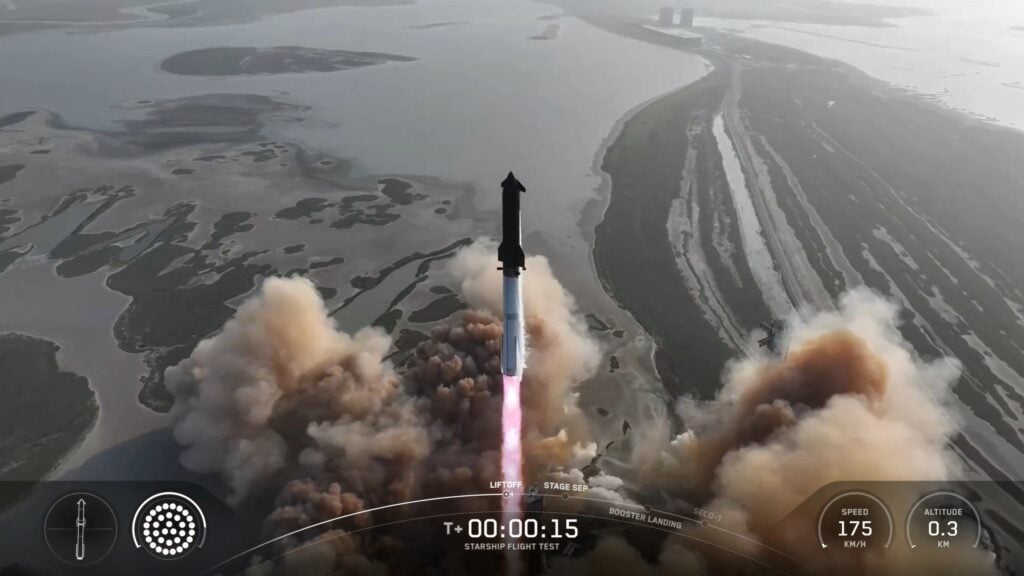
There was also progress on the Super Heavy booster. For the first time, SpaceX reused a booster from a previous flight, testing modifications aimed at improving fuel efficiency and failure recovery during landing burns. Although the booster exploded near the end of its descent rather than splashing down intact, it flew well through much of its return. SpaceX believes data from this flight will inform future attempts to catch returning boosters with launch pad arms.
The latest setback underscores the challenge of developing a fully reusable heavy-lift rocket capable of missions to the Moon and Mars. SpaceX began 2025 with ambitious goals for up to 25 test flights, but that timeline now appears unlikely. However, Musk indicated that the next three Starships could launch within weeks of each other. Meanwhile, the Federal Aviation Administration is reviewing the flight, and engineers are analyzing telemetry to confirm whether new issues or previously known problems led to the vehicle’s demise. As SpaceX prepares for its next test, company officials remain cautiously optimistic.
Read the full article at: https://arstechnica.com/space/2025/05/spacex-may-have-solved-one-problem-only-to-find-more-on-latest-starship-flight/
[ANS thanks the Stephen Clark, Ars Technica, for the above information]
The 2025 AMSAT President’s Club Coins Have Just Arrived!
Celebrating the 40th Anniversary of Amateur Radio on Human Spaceflight
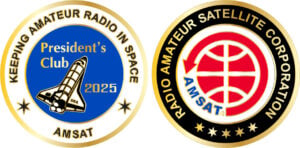
Help Support GOLF and Fox Plus.
Join the AMSAT President’s Club today!
Japanese Private Lander Resilience Nears Lunar Touchdown
Japan’s ispace is aiming for a June 5 landing attempt with its Resilience lunar lander, now orbiting the moon. The spacecraft is targeting Mare Frigoris, a volcanic plain in the moon’s northern hemisphere. If the landing succeeds, it would mark the first moon touchdown by a private Japanese company and only the second lunar landing for Japan overall.
Resilience launched on January 15 aboard a SpaceX Falcon 9 rocket, sharing the ride with Firefly Aerospace’s Blue Ghost lander. Blue Ghost landed successfully on March 2, while Resilience took a longer, energy-efficient route to the moon, entering orbit on May 6. The mission follows ispace’s earlier attempt in 2023, which failed during descent after the lander misjudged the rim of a crater.
On May 22, ispace released a photo taken by Resilience showing the moon’s south polar region. The image, posted on social media, reveals a rugged cratered surface and drew attention for an optical illusion in which the craters can appear as raised bumps. While Resilience will land far from the south pole, the photo demonstrated the spacecraft’s ability to capture detailed lunar imagery.
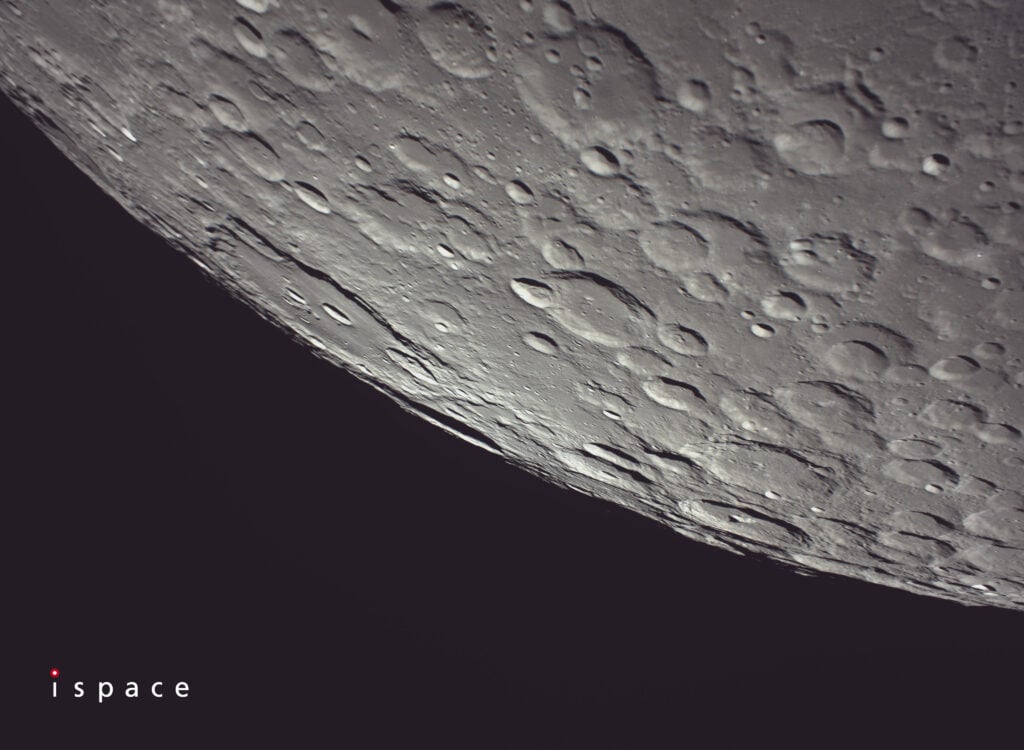
Resilience joins a growing list of privately developed missions targeting the lunar surface. It follows earlier commercial efforts like Firefly’s Blue Ghost and Intuitive Machines’ Odysseus, which landed in early 2024. These missions contribute to broader scientific and technical goals for lunar exploration.
In addition to demonstrating landing capabilities, Resilience will test technologies designed for future ispace missions, including navigation, communications, and thermal control systems. Data from the lander and its payloads will inform development of ispace’s next-generation landers, which are intended for satellite servicing and lunar cargo delivery.
Read the full article at: https://www.space.com/astronomy/moon/private-japanese-moon-probe-snaps-photo-of-lunar-south-pole-ahead-of-june-5-landing
[ANS thanks the Mike Wall, Space.com, for the above information]
GridMasterMap Satellite Top 100 Rovers June 2025 Rankings
The June 2025 rankings for the Top 100 Rovers (Mixed LEO/MEO/GEO) in satellite operations, as determined by @GridMasterMap on Twitter, has been released. The ranking is determined by the number of grids and DXCC entities activated, taking into account only those grids where a minimum number of QSOs logged on the gridmaster.fr website have been validated by a third party. Grid numbers do not directly reflect the exact number of activations. Satellite operators are encouraged to upload their LoTW satellite contacts to https://gridmaster.fr in order to provide more accurate data.
Updated: 2025-05-30
| 1 | ND9M | 26 | KX9X | 51 | EB1AO | 76 | N4UFO |
| 2 | NJ7H | 27 | ON4AUC | 52 | AC0RA | 77 | PT2AP |
| 3 | JA9KRO | 28 | KG5CCI | 53 | W7WGC | 78 | AA8CH |
| 4 | UT1FG | 29 | N5BO | 54 | XE1ET | 79 | PT9BM |
| 5 | N5UC | 30 | K8BL | 55 | N6DNM | 80 | VE1VOX |
| 6 | DL6AP | 31 | KE4AL | 56 | EA4NF | 81 | FG8OJ |
| 7 | OE3SEU | 32 | KB5FHK | 57 | SM3NRY | 82 | YU0W |
| 8 | DP0POL | 33 | PA3GAN | 58 | DF2ET | 83 | N6UTC |
| 9 | F5VMJ | 34 | F4BKV | 59 | LU4JVE | 84 | AF5CC |
| 10 | K5ZM | 35 | VE3HLS | 60 | AA5PK | 85 | KI7UXT |
| 11 | WI7P | 36 | KI0KB | 61 | KI7QEK | 86 | JM1CAX |
| 12 | LU5ILA | 37 | JO2ASQ | 62 | SP5XSD | 87 | KJ7NDY |
| 13 | N6UA | 38 | KI7UNJ | 63 | F4DXV | 88 | PS8BR |
| 14 | HA3FOK | 39 | LA9XGA | 64 | DL4EA | 89 | N4DCW |
| 15 | N9IP | 40 | BA1PK | 65 | AD7DB | 90 | WA9JBQ |
| 16 | WY7AA | 41 | VA3VGR | 66 | VE1CWJ | 91 | KB2YSI |
| 17 | W5PFG | 42 | N7AGF | 67 | KE9AJ | 92 | K0FFY |
| 18 | AK8CW | 43 | VK5DG | 68 | BG7QIW | 93 | VE3GOP |
| 19 | DL2GRC | 44 | XE3DX | 69 | N8RO | 94 | N0TEL |
| 20 | AD0DX | 45 | JL3RNZ | 70 | VA7LM | 95 | KG4AKV |
| 21 | N4AKV | 46 | PR8KW | 71 | W8LR | 96 | DK9JC |
| 22 | AD0HJ | 47 | KE0WPA | 72 | KM4LAO | 97 | W8MTB |
| 23 | WD9EWK | 48 | KE0PBR | 73 | M1DDD | 98 | CU2ZG |
| 24 | ND0C | 49 | K7TAB | 74 | W1AW | 99 | K6VHF |
| 25 | DJ8MS | 50 | JK2XXK | 75 | HB9GWJ | 100 | VE7PTN |
[ANS thanks @GridMasterMap for the above information]
Changes to AMSAT-NA TLE Distribution for May 30, 2025
Two Line Elements or TLEs, often referred to as Keplerian elements or keps in the amateur community, are the inputs to the SGP4 standard mathematical model of spacecraft orbits used by most amateur tracking programs. Weekly updates are completely adequate for most amateur satellites. TLE bulletin files are updated daily in the first hour of the UTC day. New bulletin files will be posted immediately after reliable elements become available for new amateur satellites. More information may be found at https://www.amsat.org/keplerian-elements-resources/.
NOTICE: In an effort to minimize confusion between sources of two line element sets, AMSAT is adopting the convention of listing the USSF/NORAD Satellite Catalog name first, followed by any secondary name or names in parentheses. For example, “POEM 4 (BGS ARPIT)” was added recently where “POEM 4” is the name that appears in the US Space Force Satellite Catalog, and “BGS ARPIT” is the name best known within the amateur satellite community. Expect name changes for affected satellites in the coming weeks as this change is fully implemented.
This week there are no additions or deletions to the AMSAT TLE distribution.
[ANS thanks AMSAT Orbital Elements page for the above information]
ARISS NEWS
Amateurs and others around the world may listen in on contacts between amateurs operating in schools and allowing students to interact with astronauts and cosmonauts aboard the International Space Station. The downlink frequency on which to listen is 145.800 MHz worldwide.
+ Recently Completed
Royal Moroccan Air Academy, Marrakech, Morocco, direct via CN8ERA
The ISS callsign was OR4ISS
The scheduled crewmember was Nichole Ayers KJ5GWI
The ARISS mentor was IN3GHZ
Contact was successful: Wed 2025-05-28 12:55:36 UTC
Yonezawa 5th Junior High School, Yonezawa, Japan, direct via 8N7Y5JH
The ISS callsign was OR4ISS
The scheduled crewmember was Takaya Onishi KF5LKS
The ARISS mentor was 7M3TJZ
Contact was successful: Thu 2025-05-29 09:23:02 UTC
Watch the livestream at https://www.youtube.com/live/sxpw07oNZSg
Atkarsk, Saratov region, Russia, direct via TBD
The ISS callsign was RSØISS
The scheduled crewmember was Sergey Ryzhikov
The ARISS mentor was RV3DR
Contact was successful: Thu 2025-05-29 13:55 UTC
Starominskiy District, Russia, direct via TBD
The ISS callsign was RSØISS
The scheduled crewmember was Kirill Peskov
The ARISS mentor was RV3DR
Contact was successful: Sat 2025-05-31 10:35 UTC
+ Upcoming Contacts
Technical University of Dublin, Dublin, Ireland, direct via EI1ISS
The ISS callsign is presently scheduled to be OR4ISS
The scheduled crewmember is Takaya Onishi KF5LKS
The ARISS mentor is EI8BP
Contact is go for: Wed 2025-06-04 12:07:37 UTC
Many times a school may make a last minute decision to do a Livestream or run into a last minute glitch requiring a change of the URL but we at ARISS may not get the URL in time for publication. You can always check https://live.ariss.org/ to see if a school is Livestreaming.
The crossband repeater continues to be active (145.990 MHz up {PL 67} & 437.800 MHz down). If any crewmember is so inclined, all they have to do is pick up the microphone, raise the volume up, and talk on the crossband repeater. So give a listen, you just never know.
The packet system is also active (145.825 MHz up & down).
As always, if there is an EVA, a docking, or an undocking; the ARISS radios are turned off as part of the safety protocol.
Note, all times are approximate. It is recommended that you do your own orbital prediction or start listening about 10 minutes before the listed time.
The latest information on the operation mode can be found at https://www.ariss.org/current-status-of-iss-stations.html
The latest list of frequencies in use can be found at https://www.ariss.org/contact-the-iss.html
[ANS thanks Charlie Sufana, AJ9N, one of the ARISS operation team mentors for the above information]
AMSAT Ambassador Activities
AMSAT Ambassadors provide presentations, demonstrate communicating through amateur satellites, and host information tables at club meetings, hamfests, conventions, maker faires, and other events.
AMSAT Ambassador Clint Bradford, K6LCS, says,
“Think a 75-minute presentation on “working the easy satellites” would be appropriate for your club or event? Let me know by emailing me at k6lcsclint (at) gmail (dot) com or calling me at 909-999-SATS (7287)!”
Clint has NEVER given the exact same show twice: EACH of the 150+ presentations so far has been customized/tailored to their audiences.
Scheduled Events
Rochester Amateur Radio Association Hamfest 2025 – June 21st, 2025
Barnard Fire Department Park
410 Maiden Lane
Rochester, NY 14616
KB2YSI
https://rochesterham.org/hamfest.htm
Greater Louisville Hamfest – September 6th, 2025
Paroquet Springs Conference Centre
395 Paroquet Springs Drive
Shepherdsville, KY 40165
W4FCL
https://louisvillehamfest.wixsite.com/louisvillehamfest
43rd Annual AMSAT Space Symposium & Annual General Meeting – October 16th thru 19th, 2025
Holiday Inn & Suites Phoenix Airport North
1515 North 44th Street
Phoenix, Arizona 85008
https://www.amsat.org/2025-symposium/
Interested in becoming an AMSAT Ambassador? AMSAT Ambassadors provide presentations, demonstrate communicating through amateur satellites, and host information tables at club meetings, hamfests, conventions, maker faires, and other events.
For more information go to: https://www.amsat.org/ambassador/
[ANS thanks Bo Lowrey, W4FCL, Director – AMSAT Ambassador Program, for the above information]
AMSAT Remove Before Flight Key Tags Now Available
Yes, These are the Real Thing!
Your $20 Donation Goes to Help Fly a Fox-Plus Satellite
Includes First Class Postage (Sorry – U.S. Addresses Only)
Order Today at https://www.amsat.org/product/amsat-remove-before-flight-keychain
Satellite Shorts From All Over
+ Congratulations are in order for John, AB5SS, who has earned GridMaster Award #72 for completing satellite contacts in all 488 Maidenhead grid squares across the contiguous United States. The GridMaster Award is one of the highest honors in amateur satellite operations, recognizing exceptional dedication and achievement. First created by the Star Comm Group in 2014 and supported by Damon Runion, WA4HFN, and Rick Tillman, WA4NVM, the award is now managed by AMSAT for the benefit of the entire community. To date, only a small number of operators have reached this milestone, highlighting the rarity and significance of the accomplishment. Earning GridMaster status requires years of persistence, careful tracking, and often the support of skilled satellite rovers. More information on the GridMaster Award, including how to apply, is available at https://www.amsat.org/gridmaster/. (ANS thanks Bruce Paige, KK5DO, AMSAT Director of Contests and Awards for the above information)
+ Tom Schuessler, N5HYP, is featured in the June 2025 QST “Member Spotlight” for his outstanding contributions to amateur radio satellite operations and AMSAT. A lifelong space enthusiast, Tom was encouraged by the late Keith Pugh, W5IU (SK), to explore satellites and began operating in 2010 using an Icom IC-W32A and Arrow Antenna. He quickly became hooked and joined AMSAT, later serving as an AMSAT Ambassador, giving presentations at clubs, hamfests, and virtual events like the QSO Today Virtual Ham Expo. Tom also hosts two AMSAT-focused nets in the Dallas/Fort Worth area, helping build local interest in satellite communications. One of his proudest moments was a spontaneous QSO with astronaut Woody Hoburg, KB3HTZ, aboard the ISS in 2023. His passion and outreach have made him a key figure in promoting AMSAT and inspiring others to discover the excitement of working satellites. (ANS thanks Barry Baines, WD4ASW, AMSAT Board of Directors, for the above information)
+ The European Space Agency’s ACES mission has launched the most precise atomic clock ever sent to space, with the goal of improving how we measure elevation on Earth. This effort addresses real-world issues like the infamous misalignment of a German-Swiss bridge caused by differing sea level baselines. ACES was installed on the International Space Station’s Columbus module on April 25, 2025, using the station’s robotic arm. By linking ACES to the most accurate ground-based clocks, scientists can compare how time ticks across the planet—since time passes more slowly in stronger gravity, this allows geodesists to map Earth’s gravitational field with centimeter-level precision. The clock network will eventually make elevation measurements more accurate worldwide, including in poorly surveyed regions like Africa and South America. Though ACES is just a first step, it paves the way for a future system of even more precise space-based clocks that could revolutionize infrastructure planning, sea level monitoring, and geophysical research. (ANS thanks Sophia Chen, MIT Technology Review, for the above information)
+ Starfish Space is preparing to launch its second mission, Otter Pup 2, on SpaceX’s upcoming Transporter-14 rideshare flight, where it will attempt to dock with a D-Orbit ION satellite already aboard the same launch. Unlike traditional spacecraft, Otter Pup 2 uses an electrostatic capture mechanism, allowing it to dock with unmodified satellites by attaching to flat panels. The mission aims to demonstrate rendezvous and docking technologies that will support future servicing missions, such as life extension and orbital debris inspection, for both commercial and government clients. A similar effort in 2023 failed due to a malfunction in the launch partner’s vehicle, though Otter Pup was still able to approach a different target. This mission will more realistically simulate the challenges of space servicing, with Otter Pup 2 traveling long distances before performing proximity operations and multiple dockings. Starfish hopes to prove that its technology is safe, flexible, and viable, building confidence in satellite servicing amid growing demand and regulatory interest. (ANS thanks Jeff Foust, SpaceNews, for the above information)
Join AMSAT today at https://launch.amsat.org/
In addition to regular membership, AMSAT offers membership to:
* Societies (a recognized group, clubs or organization).
* Primary and secondary school students are eligible for membership at one-half the standard yearly rate.
* Post-secondary school students enrolled in at least half-time status shall be eligible for the student rate for a maximum of 6 post-secondary years in this status.
* Memberships are available for annual and lifetime terms.
Contact info [at] amsat.org for additional membership information.
73 and remember to help Keep Amateur Radio in Space!
This week’s ANS Editor, Mitch Ahrenstorff, ADØHJ
mahrenstorff [at] amsat.org
